This step-by-step post and video will teach you how to make perfect hand-cut pappardelle pasta at home with my fresh homemade pasta dough or sourdough pasta recipe.
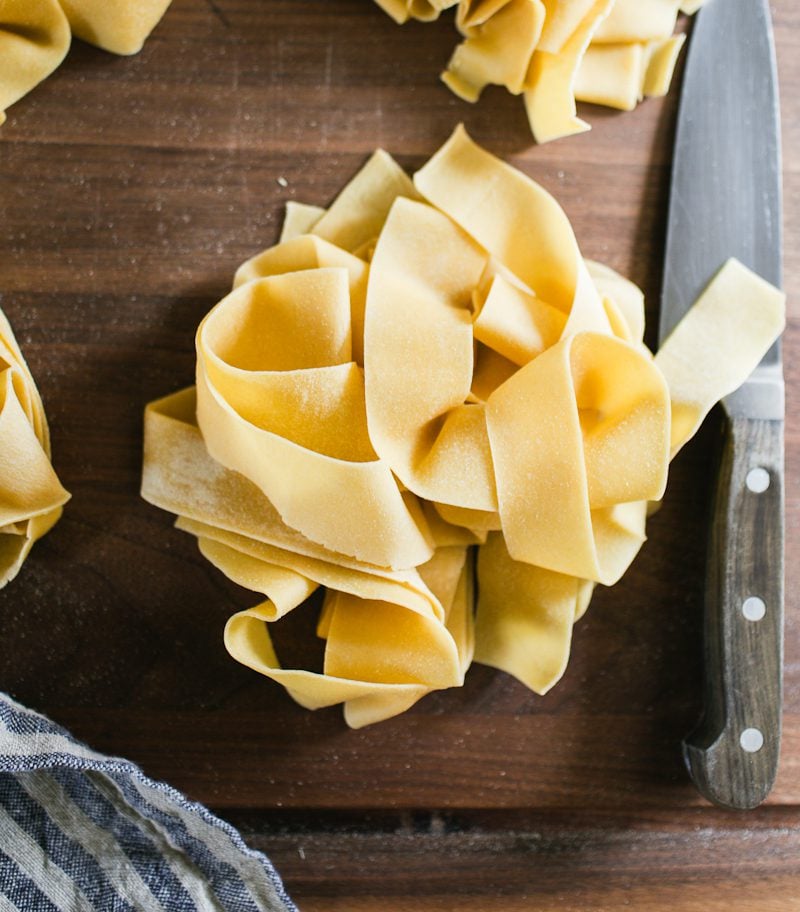
In my Beginner’s Guide, you learned how to make fresh homemade pasta dough. It’s an all- purpose pasta dough which can be used to make a variety of fresh pasta shapes, including pappardelle pasta.
In this post, I’ll show you how to do it step-by-step. It takes only minutes to do! Serve with my authentic Ragù Bolognese Sauce (pictured below), Quick Sicilian-Style Tomato Sauce or Classic Italian Basil Pesto (pesto alla Genovese) for an outstanding meal.
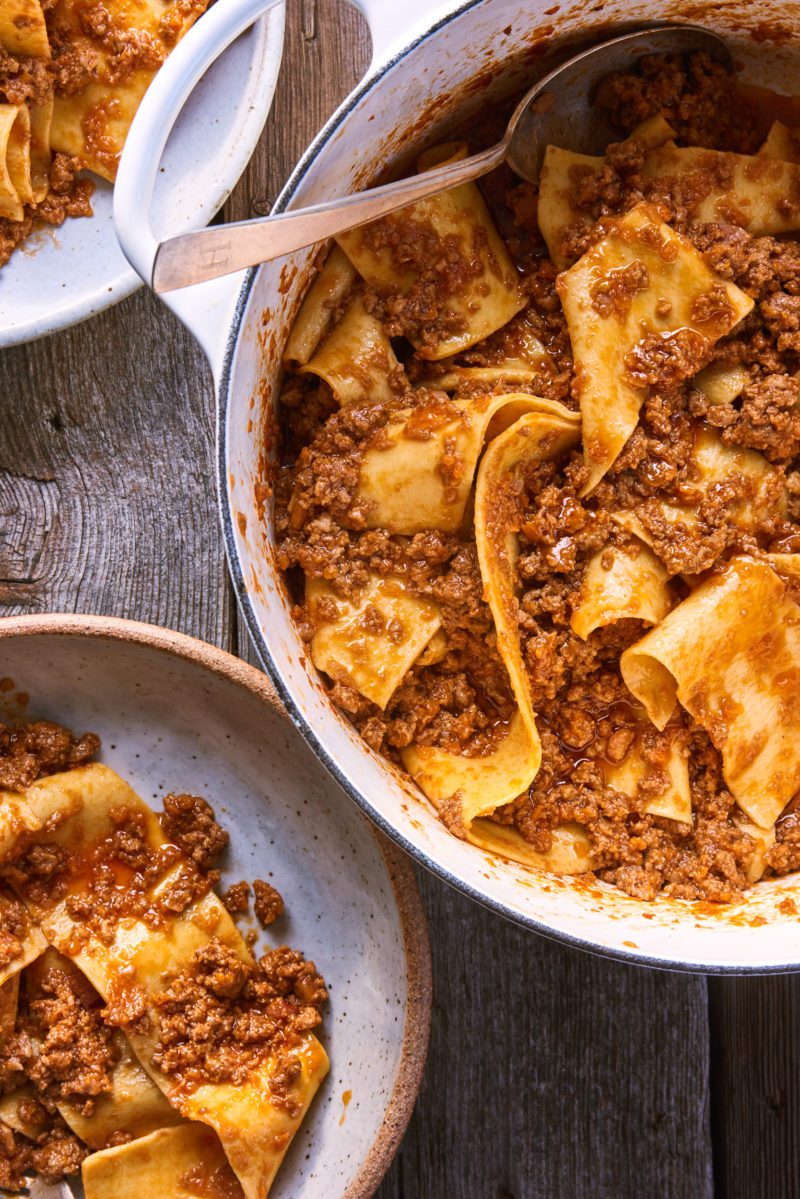
What is Pappardelle Pasta?
Pappardelle are long, wide pasta “ribbons” made from pasta dough with eggs. Because of its unique broad and flat shape, this pasta is best served with rich, hearty sauces like Ragù Bolognese or a beautiful wild mushroom sauce. Pappardelle (say it with me: “pah-ppahr-dell-eh”) has its roots in Tuscany. It can be hand-cut with a knife or fluted pastry wheel for a decorative touch.
Quick Tips:
- What is the width of pappardelle pasta? It’s usually about 1 inch (2.5 cm). However, I like mine even wider, about 1 1/2- 2 inches (3.8-5 cm).
- Pappardelle vs: Tagliatelle: What’s the difference? Simply put, it’s the width. Tagliatelle is not as wide as pappardelle pasta, about 1/2 inch (1.25 cm). The egg dough and pasta thickness, about 1/16 inch (1-2 mm) is the same. Use the method below to cut both noodle shapes.
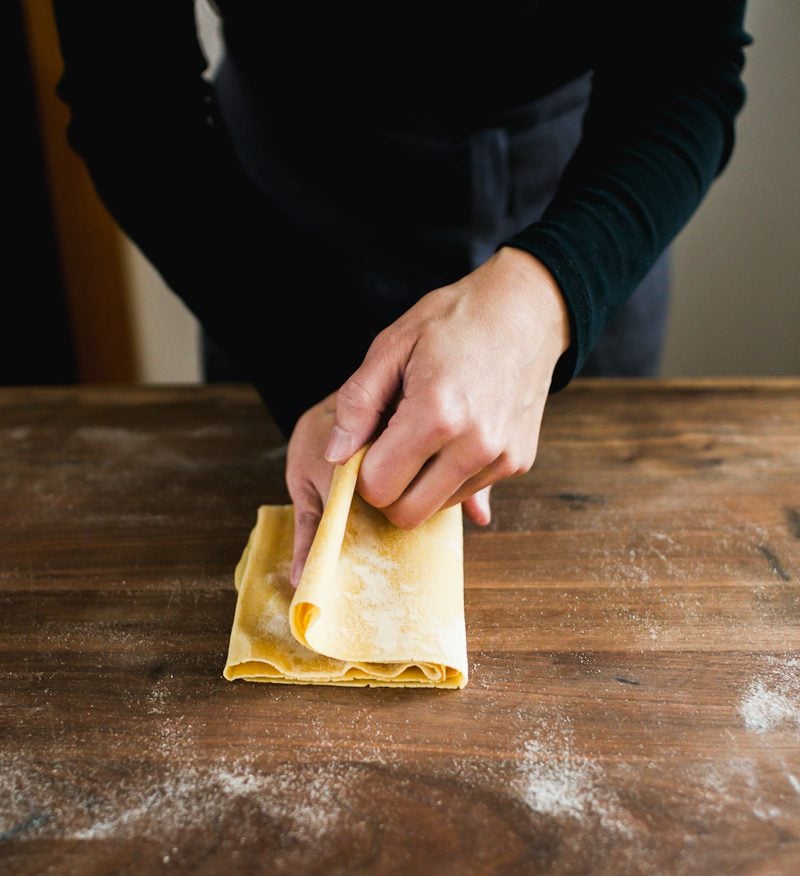
Pappardelle Pasta: How to Make it
To get started, you’ll need (1x) quantity of my fresh homemade pasta dough rolled into beautiful thin pasta sheets (see pasta recipe at the end of this post). It makes enough to feed 4 people. Then follow the how-to instructions below.
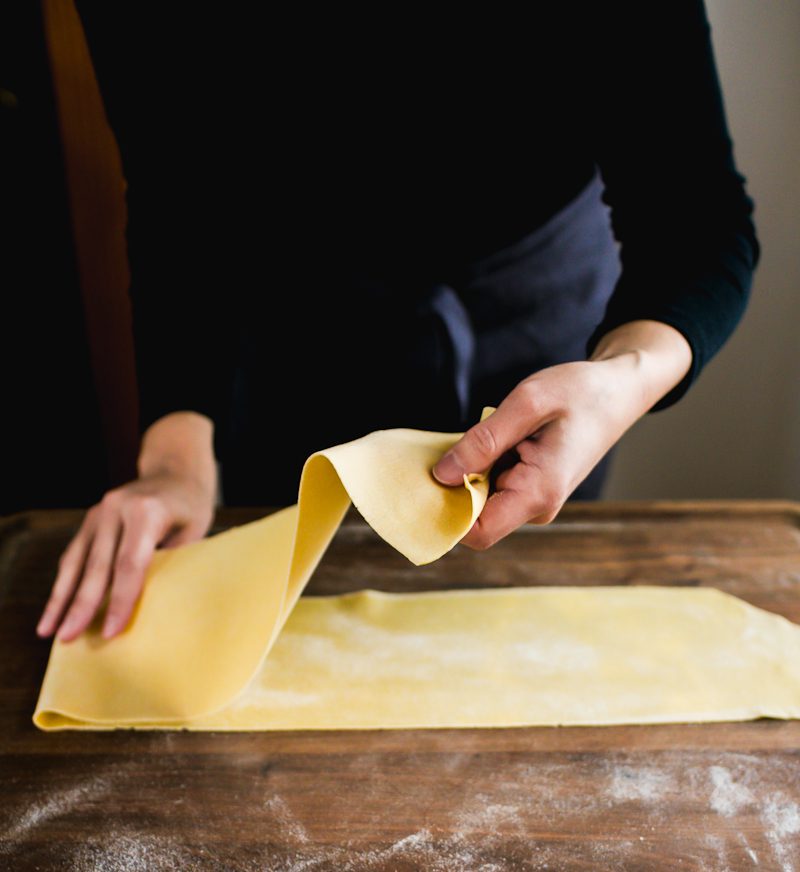
Step #1: Fold the Pasta Sheet
- Dust your work surface with fine semolina flour. Working with one sheet at a time, fold it in half like a book.
Tip: Why Semolina Flour? It absorbs less moisture than regular flour which prevents sticking. Rice flour works too.
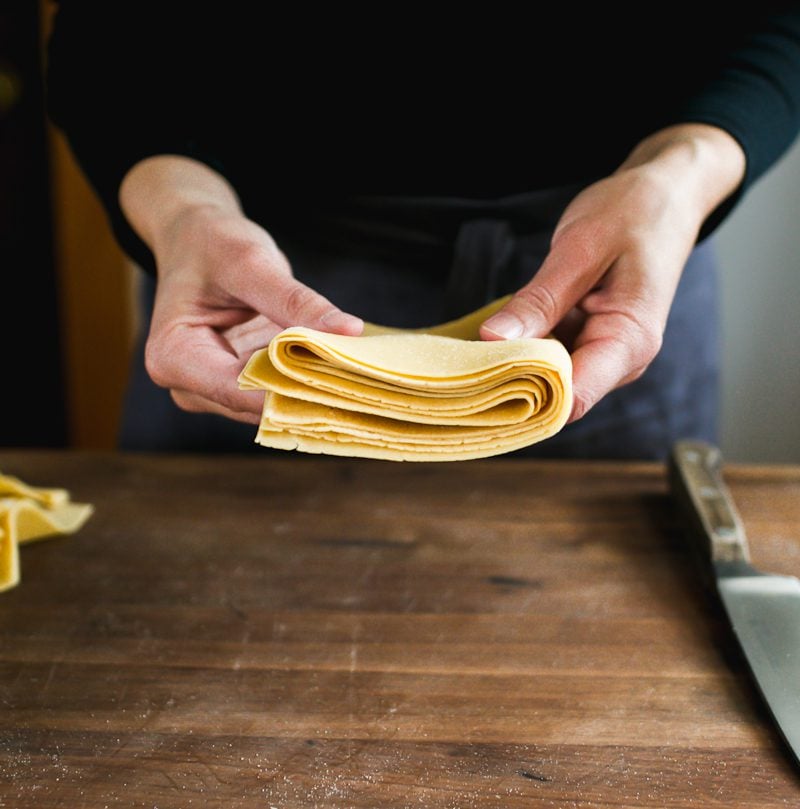
Step #2: Continue to Fold
- Now, fold it over a few more times to meet the end of the sheet (imagine folding up a carpet). You should have a neat little stack.
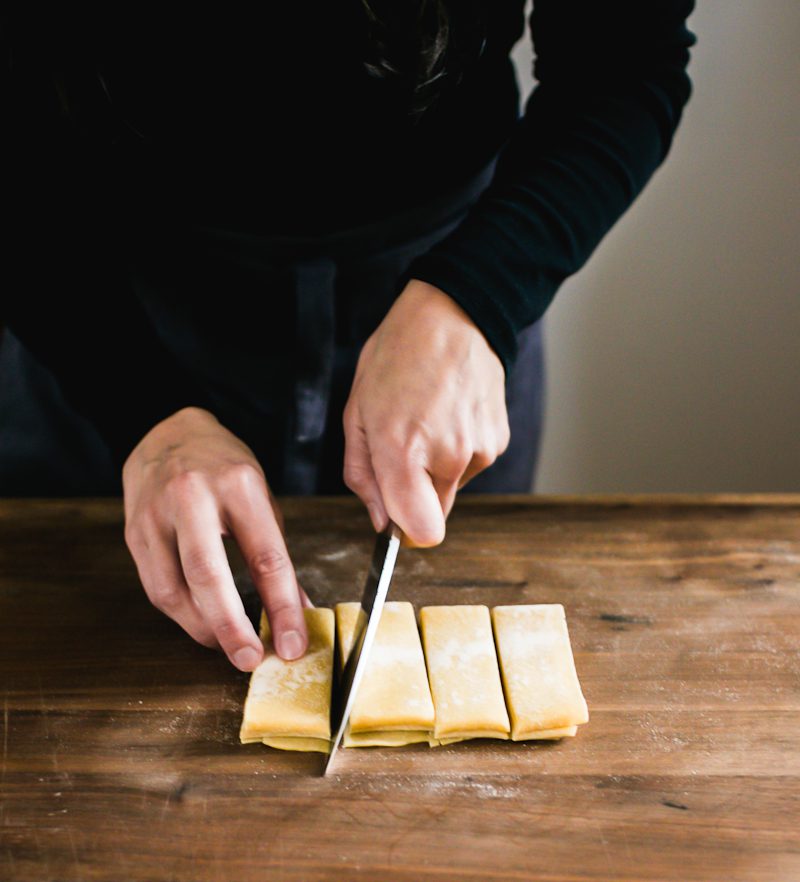
Step #3: Cut the Pasta
- With the fold facing you, cut across into 1- 1 1/2-inch (2.5-3.8 cm) wide sections.
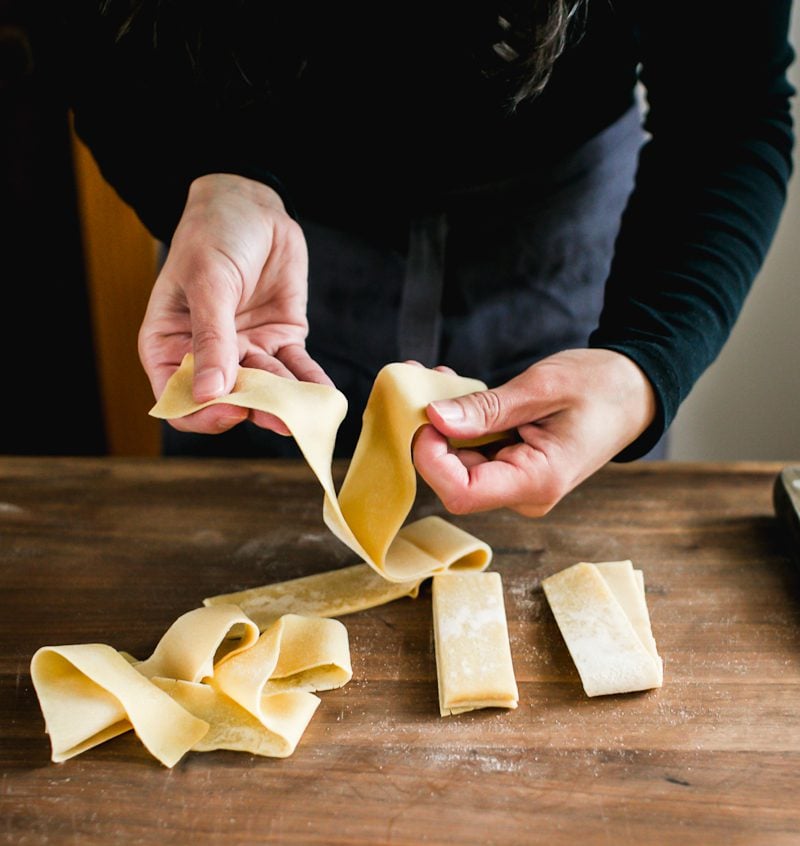
Step #4: Separate the Sections
- Unfold the pasta sections and separate into pappardelle ribbons.
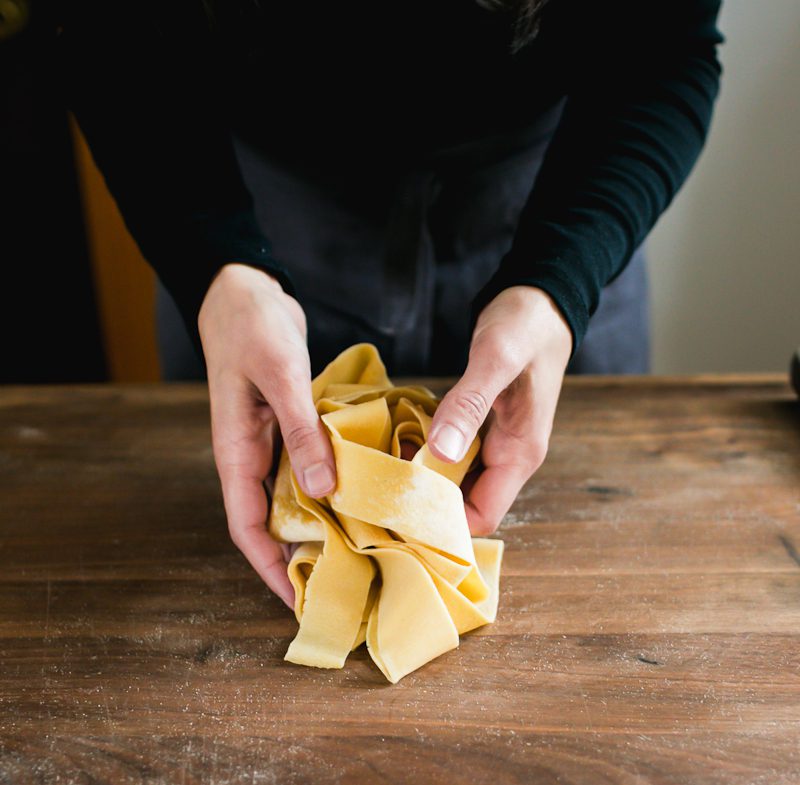
Step #5: Flour & Shake
- Dust the pappardelle with semolina flour. Gather the pasta with your hands and give it a good shake to coat. This will prevent the strands from sticking together.
What’s Next? See below for tips on how to store, freeze and cook pappardelle pasta.
How to Store Fresh Pappardelle
Arrange the pasta flat on a sheet pan dusted heavily with semolina flour. Doing so will keep the pappardelle’s broad and flat shape- it won’t curl. Cover with plastic wrap and hold at room temperature if cooking within 1-2 hours. Alternatively, refrigerate until ready to cook, up to 12 hrs. It’s best to cook homemade pasta on the same day it’s made, otherwise it might oxidize, discolor and stick together if chilled past 24 hrs.
How to Freeze Fresh Pasta
Allow the pasta to air-dry, uncovered, for up to 20 minutes before freezing. This helps to prevent sticking. Portion into ziptop bags and freeze, up to 1 month. Cook directly from frozen, no need to defrost first.
How to Cook Fresh Pasta
Add the pasta to a large pot of boiling water. Make sure to generously salt it first. Cooking time will depend on the pasta’s thickness. For pappardelle, plan on 5-7 minutes for al dente (soft but with a bite), but taste it first to be sure it’s ready. When finished, use tongs to transfer the pasta directly into the sauce.
Pappardelle Pasta Sauce Pairings:
- Ragù Bolognese Sauce
- Homemade Sausage Ragù
- Quick Sicilian-Style Tomato Sauce
- Classic Italian Basil Pesto (Pesto alla Genovese)
- Easy Pesto alla Trapanese (Sicilian Pesto)
More Homemade Pasta Recipes to Try!
- Fresh Spinach Pasta Dough
- Fresh Pappardelle with Classic Basil Pesto
- Beginner’s Guide to Fresh Homemade Gnocchi
- Beginner’s Guide to Fresh Homemade Pasta Dough
- Beginner’s Guide to Fresh Homemade Ravioli
- Beginner’s Guide to Fresh Homemade Lasagna Noodles
- Best Sourdough Pasta (1 Hour or Overnight)
*Photo credit & styling for Ragù Bolognese sauce: Melina Hammer.
Print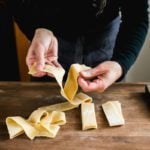
How to Make Perfect Pappardelle Pasta
- Prep Time: 1 hour
- Total Time: 1 hour
- Yield: Serves 4
- Category: Homemade Pasta
- Method: Handcrafted
- Cuisine: Italian
- Diet: Vegetarian
Description
With just 2 ingredients, flour and eggs, use this pasta dough recipe to make make any fresh pasta shape you like; pappardelle, fettuccini, ravioli and more. It’s an all purpose dough.
For timing, the process is broken up into 3 parts: making the dough, rolling the dough into pasta sheets, and cutting the pasta into noodles. Tips shared below for using a Kitchen Aid Stand Mixer, food processor and doing it by hand.
Ingredients
Pasta Dough
(1x) Fresh Homemade Pasta Dough (ingredients below)
- 300 g Tipo 00 Flour*
- 3 large eggs*
- 1 large egg yolk
- Olive oil
- Semolina flour, for dusting
*Note: For the Tipo 00 flour, I recommend Molino Grassi or Caputo. For the eggs & yolk, the total combined weight (cracked) should be 185 g. Because eggs size vary, make up the difference, if needed, with an extra egg yolk or olive oil. Olive oil makes the dough more soft, supple and satisfying to work with.
Pasta Equipment (choose one to roll the dough)
Instructions
Step #1: Make The Dough
There are 3 different ways to make pasta dough: by hand, in a stand mixer or with a food processor. Choose one of the following options below.
The Traditional Way (by hand):
- Add the flour to a large bowl. Make a well in the center; add the eggs and yolk.
- Whisk together with a fork, and then combine with the flour. When the texture becomes stiff, finish by hand to form a rough dough. If dry bits of flour remain after a few minutes of mixing (be patient, it’s a dry dough) add a few drops of water or olive oil to bring the dough together.
- Form the dough into a ball, cover with an upturned bowl or with plastic wrap, and let rest at room temperature for 10-15 minutes- it will be easier to knead.
- Knead the dough for 5-7 minutes. Do this by folding the dough over itself, pushing it forward with the heel of your hand, turning slightly as you go. I literally rock the dough back and forth (watch the video). The texture will be very stiff at first- it’s not bread dough. But rest assured, by the 2 minute mark it will start to soften. Keep kneading until the dough is soft, malleable and has a talcum-like finish. It should “bounce back” slowly when poked.
- Form the dough into a ball, cover tightly with plastic wrap, and rest at room temperature for 30 minutes.
Stand Mixer Instructions:
Fit the machine with the dough hook. Add the flour and eggs to the bowl. Mix until combined. Knead on speed #1 or #2, about 4-5 minutes. Form the dough into a ball, cover tightly with plastic wrap, and rest at room temperature for 30 minutes.
Food Processor Instructions:
Add the flour and eggs to the bowl. Pulse several times until the dough comes together. Remove the dough to your work surface and let rest for 1 minute. If the dough is a bit sticky after resting, add a sprinkle of flour. Knead by hand for 1-2 minutes (the food processor does most of the kneading for you). Form the dough into a ball, cover tightly with plastic wrap, and rest at room temperature for 30 minutes.
Step #2: Roll The Dough Into Pasta Sheets
This can be done using a KitchenAid stand mixer with the roller attachment, with a hand crank pasta machine or by hand with a rolling pin.
- Dust your work surface with semolina flour. Cut the pasta dough into 4 pieces. Working with one piece at a time, flatten the dough into a 6-8inch oval patty. Keep the remaining doughs covered in wrap otherwise they will dry out.
- If using a KitchenAid stand mixer, set the pasta roller to #1 which is the lowest/widest setting. With the machine running, send the dough through the roller. Now, send it through again (so, 2x total). Note: if using a hand crank pasta machine instead, refer to the manufacture’s specific instructions for rolling the dough (the settings might differ but the rolling process is the same). You can also use a rolling pin to roll the dough as thin as you can, about 1/16 inch (1-2 mm).
- Continue to roll the dough through settings #2-4, (2x) on each setting. Do not pull on the sheet as it comes through the roller; just guide it along gently. If at any point the dough becomes sticky, dust with semolina flour. I keep my work surface dusted with semolina at all times. This way I can coat both sides of my pasta sheet easily and quickly while I work.
- Your pasta sheet is ready when it’s beautifully thin and somewhat translucent (you should be able to see your hand underneath). Don’t worry if the ends are not perfectly straight; you can always trim them with a knife.
- To finish, dust the pasta sheet generously with semolina, fold it in half, and place onto your floured sheet pan. Cover with a kitchen towel. Repeat the rolling process for the remaining 3 doughs.
Step #3: Cut Pappardelle Pasta
- Before cutting, I like to dry my pasta sheets ever so slightly. This firms up the final texture giving the strands a more “leathery” finish, rather than a soft and doughy feel (this will prevent the pasta from sticking together later on).
- To Semi-Dry: drape the pasta sheets over the back of a chair for about 10-15 minutes or so. Keep your eye on the time; you don’t want the sheets to dry out completely. You will be able to feel the difference.
- To Cut: take a pasta sheet and cut it in half. Trim the ends, if you like. Run the sheet through your desired pasta cutter attachment to create strands. Alternatively, cut the dough by hand.
To Store: Arrange the pasta flat on a sheet pan dusted heavily with semolina flour. Doing so will keep the pappardelle’s broad and flat shape- it won’t curl. Cover with plastic wrap and hold at room temperature if cooking within 1-2 hours. Alternatively, refrigerate until ready to cook, up to 12 hrs. It’s best to cook homemade pasta on the same day it’s made, otherwise it might oxidize, discolor and stick together if chilled past 24 hrs.
To Freeze: Allow the pasta to air-dry, uncovered, for up to 20 minutes before freezing. This helps to prevent sticking. Portion into ziptop bags and freeze, up to 1 month. Cook directly from frozen, no need to defrost first.
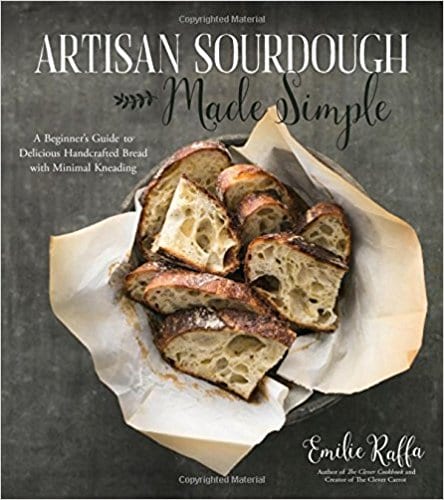

Comments
M says
How long do you cook it for?
ROBIN says
How long to boil finished pasta?
Margaret D. says
Lovely! Exactly the way my mother taught me to make the noodles for our chicken noodle soup – the only difference is we make the noodles thicker so they will soak up the broth the first day. Then we eat it the second day. Absolutely delicious! After you make your own pasta/noodles, you’ll never want to eat store-bought. I remember the first time I had store bought noodles (I was a teenager and was having dinner at a friend’s home). The noodles felt like they were just slithering down my throat with no flavor. I told my mother later that I felt so sorry for them, eating food that tasted so bad – and they didn’t know any better because they’d never had homemade noodles.
eleanor hohman says
How many cups of flour do you use.
Gordon Learn says
1 cup should equal 130g
Yvonne Holmes says
I have always wanted to make home made pasta but thought I needed an expensive machine but thanks to your easy to follow instructions on preparing the “dough” and today on the easy way to cut the beautiful pasta I am going to be making and serving my own pasta (which shall be so much more healthier for us!)
Thank you so much for walking us thru this easy step by step process.
Yvonne
Emilie Raffa says
Yvonne, you are very welcome. You can absolutely make fresh pasta at home, from start to finish, without a machine. In fact, there is a wonderful rhythm to it- the mixing, the rolling, the cutting… I find myself zoning out every time I make something! It tastes incredible too. I’ve noticed our family actually eats more when it’s freshly made. It’s less heavy. Enjoy!
Pati says
Can this be made vegan?
Emilie Raffa says
Yes, absolutely. For vegan pasta, use 330 g semolina flour + 155 g water. Follow the method for rolling and cutting the dough in this post: Beginner’s Guide to Fresh Homemade Pasta Dough.